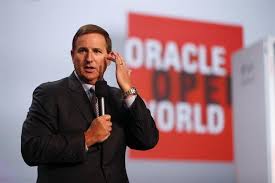On Tuesday, October 27 at Oracle OpenWorld 2015, Oracle Executive Chairman and CTO Larry Ellison emphasized the importance of "The Secure Cloud" during his keynote address. He said Oracle has always led the way with security—it's no different in the cloud.
He emphasized the following points:
|
"Oracle wants to remove the 'off' switch from security" - Larry Ellison
2025 Cloud Predictions by Oracle CEO Mark Hurd
 In a Keynote speech Oracle Open World 2015 on Monday, Oracle CEO Mark Hurd pointed out five cloud-related predictions for 2025. He said:
Mark Hurd declared that ORACLE will be the company "to lead this 10 year transition to the cloud." Read More >> |
HP will deliver exciting announcements on Private Cloud Offerings
HP announced plans to officially close down its public cloud effort and give up on competing with Amazon Web Services, Google, and Microsoft Azure in that market. The news came via a blog post written by Bill Hilf, senior VP and GM of HP Cloud. Hilf explained in his blog "a new model to deliver public cloud". He said: "we will sunset our HP Helion Public Cloud offering on January 31, 2016. As we have before, we will help our customers design, build and run the best cloud environments suited to their needs - based on their workloads and their business and industry requirements." With this he added that they will continue to aggressively grow their partner ecosystem and integrate different public cloud environments, big names as mainly being AWS and Microsoft. Hilf announced that HP will focus its resources on their Managed and Virtual Private Cloud offerings. He said that "these offerings will continue to expand, and we will have some very exciting announcements on these fronts in the coming weeks". Read More >> |
IT cloud veterans warns to avoid the technology pitfalls
1. Be prepared to deal with old legacy systems
Landon Williams, vice president of Infrastructure Architecture and Services at The Weather Company, the parent company behind The Weather Channel, weather.com and Weather Underground. Williams said his company has migrated 80% of its services and apps to the cloud. Now they are facing the really hard part – that last 20%.
2. Don’t repurpose old hardware
Tom Soderstrom, chief technology officer for NASA’s Jet Propulsion Laboratory, warned conference attendees not to bring their old hardware into a new private cloud.
3. Don’t screw up something critical
Soderstrom said that some IT leaders want to jump into the cloud with their biggest, shiniest app or service. Just don’t. Start with something small.
4. Don’t get stuck in analysis paralysis
Stephen Orban, the head of enterprise strategy at AWS and the former CIO and global head of technology at Dow Jones & Co., said he too often sees enterprises get stuck in the planning stages. Mired in spreadsheets, plans and what-ifs, they never get out of the starting gate.
5. Don’t neglect a strong network connection
Eric Geiger, vice president of IT operations at Federal Home Loan Bank of Chicago, said IT leaders need to make sure they have a good network connection.
6. Code once, deploy twice
Ariel Kelman, vice president of worldwide marketing at AWS, warned that IT managers need to make sure that they’re coding as efficiently, across networks, as they can.
7. Moving to the cloud will be harder without the right people in the right jobs
John Trujillo, assistant vice president of technology at Pacific Life Insurance Co., said figuring out what jobs won’t be needed, who can take on new roles and who needs more training will be key to a clean migration and cloud run. |
Turkish Scientist Aziz Sancar was awarded The Nobel Prize in Chemistry 2015
Turkish Scientist Aziz Sancar was awarded The Nobel Prize in Chemistry 2015 The cells’ toolbox for DNA repair
Tomas Lindahl, Paul Modrich and Aziz Sancar for having mapped, at a molecular level, how cells repair damaged DNA and safeguard the genetic information. Their work has provided fundamental knowledge of how a living cell functions and is, for instance, used for the development of new cancer treatments.
Each day our DNA is damaged by UV radiation, free radicals and other carcinogenic substances, but even without such external attacks, a DNA molecule is inherently unstable. Thousands of spontaneous changes to a cell’s genome occur on a daily basis. Furthermore, defects can also arise when DNA is copied during cell division, a process that occurs several million times every day in the human body.
The reason our genetic material does not disintegrate into complete chemical chaos is that a host of molecular systems continuously monitor and repair DNA. The Nobel Prize in Chemistry 2015 awards three pioneering scientists who have mapped how several of these repair systems function at a detailed molecular level.
|
Subscribe to:
Posts (Atom)




